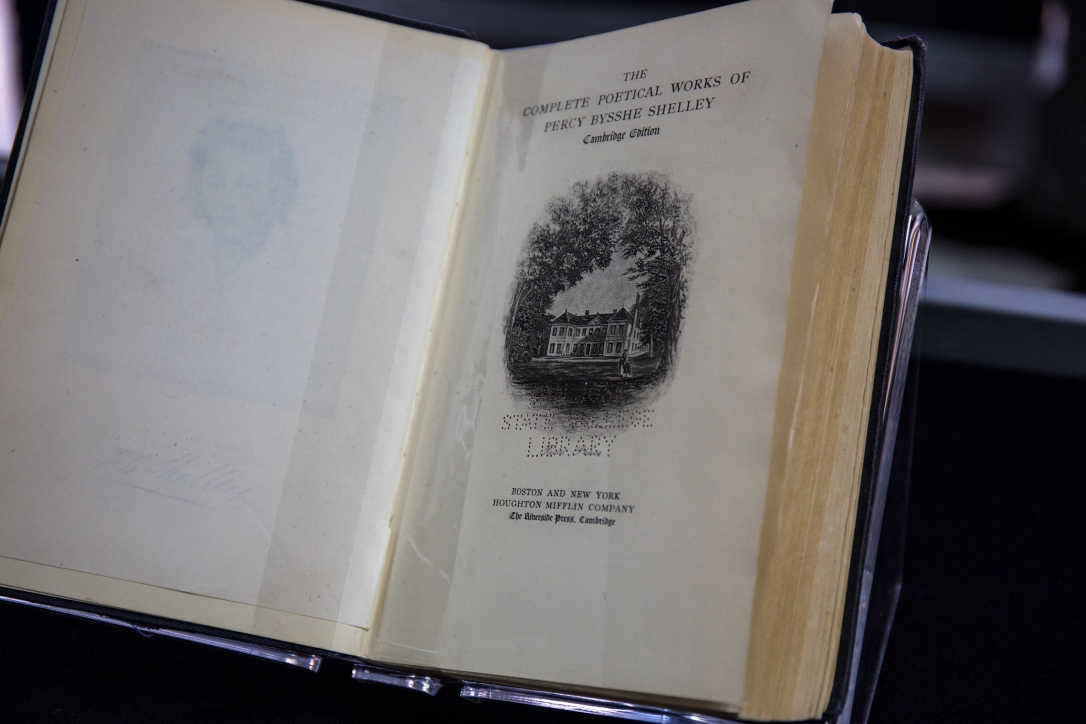
Curated by Director of Special Collections & Archives, Craig Simpson, in collaboration with SJSU English majors, Natalie Garcia, Shelby Escott, and Jonathan Gill, SJSU’s Special Collections & Archives offers this physical exhibit at SJSU’s 5th floor display space.
Both the physical exhibit and this digital exhibit celebrate the 200th anniversary of one of the most influential novels ever written. In 1818, Mary Shelley published Frankenstein: or, The Modern Prometheus, which set the standard for what has become a classic horror and science-fiction template: the groundbreaking scientific experiment that goes terribly wrong. Shelley’s novel originated during the summer of 1816, when Mary and her husband Percy Shelley joined a circle of friends at Lake Geneva, one of whom was Lord Byron. It was Byron who proposed that each person write “a ghost story” to pass the time. Considerably more radical than Byron’s suggestion, Mary’s story was completed the following spring, when she was nineteen years old, and published anonymously on January 1, 1818. She describes the creative process (and her genius) in the 1831 Introduction to the second edition — an introduction that echoes those watery, yellow eyes of the creature upon its creation.
While rooted in the Gothic literature of its era, Frankenstein has been adapted over two centuries to seemingly endless forms of creative expression—books, movies, poems, graphic novels, ballet, and opera, to name a few. Unlike the fate of Victor Frankenstein’s “creature” (also called “monster,” “wretch,” “fiend”), Mary Shelley’s most significant creation has proven itself immortal.
Visit the SJSU exhibit in-person at the 5th floor exhibit space (outside the elevators), Dr. Martin Luther King, Jr. Library, San Jose State University. On display until November 15.
Frankenstein (manuscript reproduction)
This special edition, published in 2018 to commemorate the novel’s 200th anniversary, offers a facsimile of Mary Shelley’s original handwritten manuscript. Her draft was written in two large notebooks and included annotations and sketches by Percy Shelley. The Editor’s Note to this edition reads: “Through the numerous corrections, additions, and changes, the reader can see the text being reworked and strengthened as the novel’s famous monster takes form and becomes more human.”
Pictured, pages from Chapter 11, detail the creature’s fearful flight from Victor’s laboratory. Mary’s line that begins, “One day, when I was oppressed by cold, I found a fire which had been left by some wandering beggars, and was overcome with delight,” contains an addition by Percy in the margins that is in the published novel: “at the warmth which I so experienced from it.” (SJSU Catalog Description)
A Vindication of the Rights of Woman:
with Strictures on Political and Moral Subjects by Mary Wollstonecraft
Mary (Godwin) Shelley was born on August 30, 1797 to philosophers William Godwin and Mary Wollstonecraft. Her mother’s most renowned work, A Vindication of the Rights of Woman (published 1792), was one of the earliest treatises on feminist philosophy and a powerful rebuke against the beliefs at the time of many men that women should not have an education. Mary Wollstonecraft died less than two weeks after giving birth to her second daughter, Mary, on September 10, 1797. (SJSU Catalog Description)
The Complete Poetical Works of Percy Bysshe Shelley

Regarded as one of the greatest poets of English Romanticism, Percy Shelley (b. August 4, 1792—d. July 8, 1822) became lovers with Mary Godwin while he was married to his first wife, Harriet Westbrook. They ran away together to Switzerland in 1814, when Mary was sixteen years old. His first wife, Harriet, drowned herself on December 10, 1816. Percy and Mary wed on December 30 of that year. Percy Shelley himself drowned in a storm in the Gulf of Spezia in 1822.
Mary Shelley’s Tales and Stories

Published posthumously in 1891, forty years after her death of February 1, 1815, Tales and Stories demonstrates her versatility of interests, even though it includes “Transformation,” a variation on Frankenstein, about a young man who switches bodies with a strange creature. It was first published in The Keepsake in 1831. (SJSU catalog description)
Frankenstein Libretto (1979) by John Gardner
Gardner published this Frankenstein libretto in 1979, warned that the opera was not intended to be “psychologically realistic, nor is it meant to follow the traditional story—Mary Shelley’s, on the one hand, or Boris Karloff’s, on the other.” Gardner had an affinity for literary monsters: his most famous work was the novel Grendel (1971), a reimagining of Beowulf from the monster’s perspective. (SJSU Catalog Description)
Dean Koontz’s Frankenstein (graphic novel series)
Dean Koontz’s Frankenstein is a five-part series of novels published between 2004 and 2010. The series serves as a modern retelling and pseudo-sequel to Mary Shelley’s Frankenstein. The series takes place in New Orleans and Victor’s original creature takes the name Deucalion (named after the son of Prometheus). The modern setting sees Frankenstein creating life through the application of robotics, creating artificial life and bio-synthetic humans. (Loaned by Diane Malmstrom)
The New Annotated Frankenstein (2017)
In his Introduction, filmmaker Guillermo del Toro (The Shape of Water) writes about the first time he read Frankenstein as a teenager: “The first thing that struck me was its literary devices—it was the first epistolary novel I had ever read—and the fact that in many ways, it bore little resemblance to its filmic counterparts…Shelley’s book moved me to tears. I wept for the monster and admired his thirst for revenge. It spoke to me about the essential contradictions of the spirit and the world. And beyond the tragedy of it all a notion emerged that was demolishing to me: the villain of the piece was life.” (Loaned by Natalie Garcia)
Frankenstein (1983)
Stephen King’s introduction to this 1983 publication of Frankenstein features high praise for the vivid illustrations by Bernie Wrightson. (Loaned by Diane Malmstrom)
Human Microchip Implant and Biohacking (2017)
A humorous, whimsical addition to our display, or an alarming example of Shelley’s prophecy about the amalgamation between humanity and technology?
Acknowledgements
All photographs courtesy of Jack Zhen, staff photographer for SJSU Humanities & Arts Marketing.
Digital exhibit and item descriptions created by English major, Jonathan Gill. Thank you to graduated English majors,Natalie Garcia and Shelby Escott, for their early work on selecting and annotating materials in Spring 2018.
Special thanks to SJSU Special Collections & Archives Director, Craig Simpson, for curating the exhibit. Dean Shannon Miller and Dean Tracy Elliot were instrumental in supporting all of the Frankenstein Bicentennial collaborations throughout 2018.
Special thanks to the regional partners, Dr. Kirstyn Leuner (Santa Clara University) and Dr. Omar Miranda (University of San Francisco).
About Frankenstein@200 Series
Published in 1818, Mary Shelley’s classic novel Frankenstein has remained an important tool in exploring what occurs when science and technology are pushed to the limits. Several events have been planned for Fall 2018 to continue to celebrate the 200th anniversary of this timely and revolutionary story. To find out more about the events that will be featured, visit Upcoming Events. To stay in the loop about all things Frankenstein, follow these social media accounts:
This event is sponsored by an SJSU Artistic Excellence Programming Grant, and is also supported by 

1 thought on “200 Years of Mary Shelley’s Frankenstein”